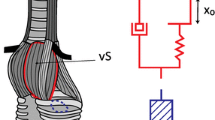Abstract
Behavior emerges as the nervous system generates motor patterns in charge of driving a peripheral biomechanical device. For several cases in the animal kingdom, it has been identified that the motor patterns used in order to accomplish a diversity of tasks are the different solutions of a simple, low dimensional nonlinear dynamical system. Yet, motor patterns emerge from the interaction of an enormous number of individual dynamical units. In this work, we study the dynamics of the average activity of a large set of coupled excitable units which are periodically forced. We show that low dimensional, yet non trivial dynamics emerges. As a case study, we analyze the air sac pressure patterns used by domestic canaries during song, which consists of a succession of repetitions of different syllable types. We show that the pressure patterns used to generate different syllables can be approximated by the solutions of the investigated model. In this way, we are capable of integrating different description scales of our problem.
Similar content being viewed by others
References
M.S. Golubitsky, I. Stewart, B. Pietro-Luciano, J.J. Collins, Nature 410, 693 (1999)
L.M. Alonso, J.A. Alliende, F. Goller, G.B. Mindlin, Phys. Rev. E 79, 041929 (2009)
Y. Kuramoto, Self-entrainment of a population of coupled nonlinear oscillators, Lecture notes in Physics (Springer, New York, 1975), Vol. 39, pp. 420–422
A. Pikovsky, M. Rosenblum, J. Kurths, Synchronization: A universal concept in nonlinear science (Cambridge University Press, Cambridge, 2001)
E. Ott, T.M. Antonsen, Chaos 18, 037113 (2008)
E. Ott, T.M. Antonsen, Chaos 19, 023117 (2009)
L.M. Childs, S.H. Strogatz, Chaos 18, 043128 (2008)
E.M. Izhikevich, IEEE Trans. Neural Netw. 10, 479 (1999)
F.C. Hoppensteadt, E.M. Izhikevich, Weakly connected neural networks (Springer-Verlag New York, 1997)
T. Gardner, G. Cecchi, M. Magnasco, R. Laje, G.B. Mindlin, Phys. Rev. Lett. 87, 208101 (2001)
G.B. Mindlin, R. Laje, The physics of birdsong (Springer, 2005)
F. Goller, R.A. Suthers, J. Neurophysiol. 75, 867 (1996)
M.A. Trevisan, G.B. Mindlin, F. Goller, Phys. Rev. Lett. 96, 058103 (2006)
R. Gilmore, M. Lefranc, The topology of chaos (Wiley, Hoboken, 2002)
M.S. Brainard, The anterior forebrain pathway and vocal plasticity, in Neuroscience of birdsong, edited by H.P. Zeigler, P. Marler (Cambridge University Press, Cambridge, 2008)
M. Mitchell, An introduction to genetic algorithms (MIT press, Cambridge, 1998)
Author information
Authors and Affiliations
Corresponding author
Rights and permissions
About this article
Cite this article
Alonso, L., Alliende, J. & Mindlin, G. Dynamical origin of complex motor patterns. Eur. Phys. J. D 60, 361–367 (2010). https://doi.org/10.1140/epjd/e2010-00225-2
Received:
Revised:
Published:
Issue Date:
DOI: https://doi.org/10.1140/epjd/e2010-00225-2




